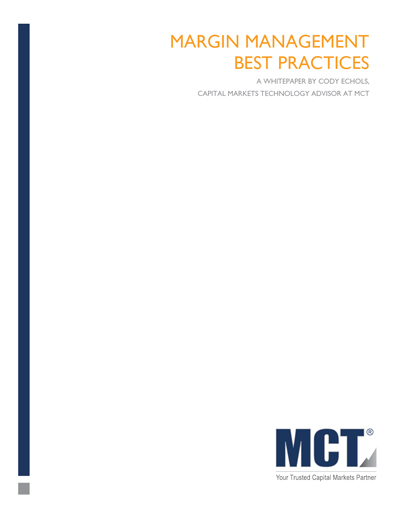
MCT Whitepaper: Margin Management Best Practices
This whitepaper provides an overview into the complexities of margin management within the dynamic mortgage lending landscape. Against the backdrop of evolving market dynamics, this paper elucidates the crucial role of recalibrated margin management strategies.
MCT’s Capital Markets Technology Advisor, Cody Echols, unravels the complexities, challenges, and actionable techniques to boost profit margins and navigate lending volumes with agility.
Fill out the form to download the whitepaper.
Download Whitepaper
Topics Include:
- Margin Management Through Historical Highs and Lows
- Set It & Forget It vs. Analysis & Active Management
- Margin Management Data & Analytics
- Rate Sheet Considerations
Download our whitepaper today to learn more about margin management best practices!

Cody Echols - CMTA, South and Southeast Sales Regions
In his role as a Capital Markets Technology Advisor, Cody Echols leverages his years of capital markets, leadership, and coaching experience to help MCT clients exceed their goals. His demonstrated capabilities in mortgage operations and technology ensure a successful onboarding experience for new clients, as well as a hands-on approach to ensuring current users are able to conquer new market challenges as they arise. Mr. Echols is also experienced in managing integrations, product and pricing development, hedging strategy, and compliance requirements. This has enabled him to create educational material such as training guides as well as author the daily market commentary.

The Impact of Historical Highs
When looking back in recent history, margin management over the twelve months from 2020-2021 could very easily become a lost art. There was a combination of staggering volumes and exploding margins that made it nearly impossible not to post record profits. Most lenders were preoccupied just trying to figure out how they were going to turn their inadequate warehouse lines or find another fifty loans to send through their already exhausted operations team. The last thing they had bandwidth for was micromanaging their margins, which left a large vulnerability, and many lenders were later forced to close their doors during the next economic downturn.
What Should a Lender Consider in their Margin Management Decision?
Understanding a lender’s unique cost to originate is often the best starting point in setting margin. It may also open doors to other issues operationally which could further that lender’s ability to set margin more competitively. Investment in technology is paramount in today’s environment. Focusing on this one area can lead to reduced cycle time, increased efficiencies, higher customer satisfaction, and a referral basis that promotes additional growth as well as improving overall pull-through rates. Technology can come at a cost that must be factored into the overall cost to originate, but if implementation leads to gains that exceed the current process costs it is worth the money spent.
Competitive Rate Comparison
Understanding your competitive position within the marketplace is extremely important to drive business, especially in today’s highly competitive environment.
Subscribing to third party competitive intelligence data can be helpful when coupled with cost to originate as a backdrop. Remember that there can be more than just the note rate and discount or premium in comparison. Fee structure can also play a big role in a consumer’s decision when looking at various lenders. The Consumer Financial Protection Bureau promotes that consumers review multiple lenders before deciding on which one to go with. APR, or the annual percentage rate, is often overlooked by the consumer but is a great tool to look at the overall cost to the consumer for taking out the loan. APR includes not only the rate and points being offered but also the fee structure.

